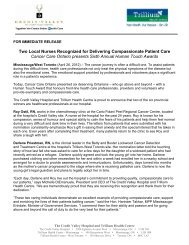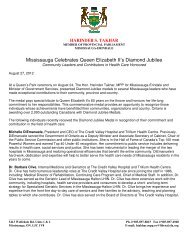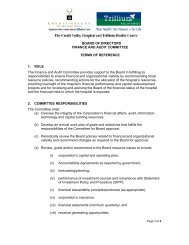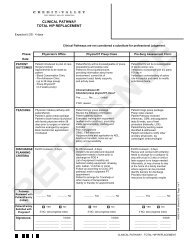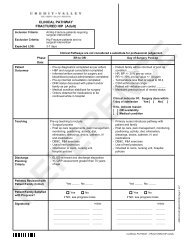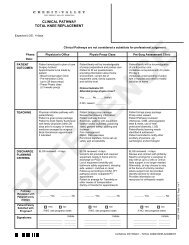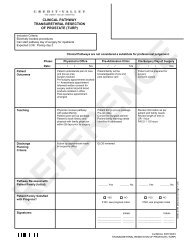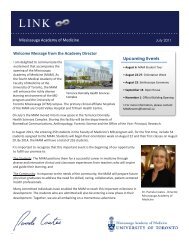Download Soft Fetal Ultrasound Findings - Credit Valley Hospital
Download Soft Fetal Ultrasound Findings - Credit Valley Hospital
Download Soft Fetal Ultrasound Findings - Credit Valley Hospital
Create successful ePaper yourself
Turn your PDF publications into a flip-book with our unique Google optimized e-Paper software.
SOFT FETAL<br />
ULTRASOUND FINDINGS<br />
Compiled by the Genetics Team at The <strong>Credit</strong> <strong>Valley</strong> <strong>Hospital</strong><br />
Last updated February 2008
<strong>Soft</strong> <strong>Fetal</strong> <strong>Ultrasound</strong> <strong>Findings</strong><br />
Page 2<br />
This document refers to the ultrasound finding of a soft sign, as compared to a clear cut<br />
structural anomaly. There is very little information about outcomes when more than<br />
one soft finding is seen on a fetal ultrasound. The information herein refers to isolated<br />
soft findings, meaning the ultrasound is otherwise unremarkable.<br />
If the ultrasound is done at a gestation earlier than 18 weeks, a detailed fetal ultrasound<br />
around 18-19 weeks can be considered, since visualization of the fetus is better at later<br />
gestations, allowing for exclusion of other soft signs, and a better assessment of the<br />
original finding. However, in many of the soft ultrasound findings, the natural history is<br />
that the sign can disappear, but one cannot fully ignore the original finding.<br />
The impact of Maternal Serum Screening (MSS) or Integrated Prenatal Screening (IPS)<br />
in estimating the risk of a true fetal chromosome anomaly in the presence of a soft<br />
ultrasound finding is unknown. Only for a choroid plexus cyst has the literature begun<br />
to evaluate the contribution of MSS or IPS.<br />
It is important to remember that the risk of a significant fetal chromosome anomaly<br />
increases with maternal age. A woman is eligible for prenatal chromosome testing<br />
when she is 35 or greater at the time of delivery (32 or older if twins).<br />
Although likelihood risks have been estimated for some of the soft signs, it is important<br />
to note that in many of the references below, the women were from high risk categories,<br />
potentially inflating the risk estimates. Also, often the number of cases reported is<br />
small.<br />
General References:<br />
Shipp and Benacerraf (2002). Second trimester screening for chromosome<br />
abnormalities. Prenatal Diagnosis 22:296-307.<br />
Smith-Bindman R. et al (2001). Second-trimester ultrasound to detect fetuses with<br />
Down syndrome. JAMA 285:1044-1055.<br />
Van den Hof MC. et al. (2005). <strong>Fetal</strong> soft markers in obstetric ultrasound. JOGC<br />
27:592-612.<br />
2
CONTENTS<br />
FIRST TRIMESTER SOFT SIGNS<br />
1. Absent nasal bone<br />
2. Increased nuchal translucency<br />
SECOND TRIMESTER SOFT SIGNS<br />
1. Choroid plexus cyst<br />
2. Drooping choroids<br />
3. Mild ventriculomegaly<br />
4. Enlarged cistern magna<br />
5. Nasal bone hypoplasia<br />
6. Increased nuchal fold<br />
7. Echogenic cardiac focus<br />
8. Single umbilical artery<br />
9. Pyelectasis<br />
10.Echogenic bowel<br />
11.Short femur<br />
12.Short humerus<br />
<strong>Soft</strong> <strong>Fetal</strong> <strong>Ultrasound</strong> <strong>Findings</strong><br />
Page 3<br />
3
<strong>Soft</strong> <strong>Fetal</strong> <strong>Ultrasound</strong> <strong>Findings</strong><br />
Page 4<br />
1. ABSENT NASAL BONE February 2008<br />
A small nose and midface hypoplasia are well-recognized clinical features of Down<br />
syndrome. Nasal bone ossification has been absent in a significant number of aborted<br />
fetuses with DS of varying gestations. This information provided credence to the idea of<br />
prenatal first trimester study of the nasal bone as an additional marker for DS.<br />
Required components for nasal bone imaging have been suggested (2) . This includes a<br />
mid-sagittal view of the fetus with the fetus occupying most of the image with clear fetal<br />
margins.<br />
Several studies have now been published suggesting the absence of the nasal bone in<br />
the first trimester is associated with DS. The majority of studies emerge from Cicero et<br />
al (Nicolaides group in the UK) (1) . Six important pieces of information have emerged:<br />
• Nasal bone more likely to be absent at earlier gestations. In euploid fetuses with<br />
CRL between 45 and 54 mm, the nasal bone was absent in 4.7% cases. At CRL<br />
between 75 and 84 mm, the nasal bone was absent in only 1% of cases. Nasal<br />
bone assessment should be limited to first trimester fetuses with CRL> 45 mm.<br />
• Data in the studies are from a high-risk pregnancy group. Low risk population yet<br />
to be studied. Prefumo et al (3) suggest nasal bone hypoplasia performs poorly as<br />
a marker for DS in an unselected population. This raises the question of its use<br />
as a secondary marker rather than a primary marker.<br />
• Examining a high-risk group opting for CVS, the nasal bone was absent in 43/59<br />
(73%) trisomy 21 fetuses and only 3/603 (0.5%) euploid fetuses. If this<br />
ultrasound sign is combined with NT and biochemistry markers it is predicted the<br />
detection of DS would increase to 93% with the same false positive rate of 5%.<br />
• The same investigators found that absence of the nasal bone is also associated<br />
with trisomy 18, trisomy 13, and monosomy X.<br />
• There appears to be an association between absent nasal bone, fetal crownrump<br />
length, and nuchal translucency. In aneuploid pregnancies, nasal bone<br />
absence occurs more frequently with increasing NT. When NT was at the 95 th<br />
percentile or less the likelihood of absent nasal bone was greatest. The<br />
likelihood decreased as the NT increased.<br />
• There is a relationship between ethnicity and nasal bone development.<br />
Further evaluation of nasal bone assessment performance in a low risk population must<br />
be determined and sufficient adequately trained centres with appropriate educational<br />
and credentialing procedures must be available before this can be used as part of<br />
provincial screening in Ontario. However, use of this ultrasound marker as an<br />
independent determinant of fetal chromosome testing cannot be ignored in first<br />
trimester fetuses with CRL>45 mm.<br />
4
References:<br />
<strong>Soft</strong> <strong>Fetal</strong> <strong>Ultrasound</strong> <strong>Findings</strong><br />
Page 5<br />
1. Cicero S et al. (2006) Nasal bone in first-trimester screening for trisomy 21. Am J<br />
Obstet Gynecol 195:109-114<br />
2. Rosen T et al. (2007) First-trimester ultrasound assessment of the nasal bone to<br />
screen for aneuploidy. Obstet and Gynecol. 110:2(1)399-404<br />
3. Prefumo F et al. (2006) First-trimester nuchal translucency, nasal bones, and<br />
trisomy 21 in selected and unselected populations. Am J Obstet Gynecol<br />
194:828-833<br />
5
<strong>Soft</strong> <strong>Fetal</strong> <strong>Ultrasound</strong> <strong>Findings</strong><br />
Page 6<br />
2. INCREASED FETAL NUCHAL TRANSLUCENCY 11-14 weeks February 2008<br />
Nuchal translucency (NT) is the sonographic appearance of a subcutaneous collection<br />
of fluid behind the fetal neck. The 95th percentile measurement is 3.0 mm (which<br />
advances slightly with gestational age), and 99 th percentile measurement is constant at<br />
3.5 mm. NOTE: reliability of the measurement is operator dependent. Typically, this<br />
measurement is done as part of Integrated Prenatal Screening (IPS) or First Trimester<br />
Screening (FTS). Screening using only the NT is to be discouraged. However, if the<br />
measurement is significantly increased, it warrants offering counselling.<br />
Associations:<br />
An increased NT per se does not constitute a fetal abnormality.<br />
The larger the NT measurement, the greater is the risk of an adverse outcome.<br />
• Chromosome anomalies (50% trisomy 21, 25 % trisomy 13/18, 10% Turner<br />
syndrome, 10% other)<br />
• congenital heart disease (>99 th centile -> overall likelihood ratio of 22.5 X population<br />
risk, with 1% of screened population > 99 th centile, somewhat correlates with the<br />
size of the NT<br />
• single gene conditions, (with or without mental handicap)<br />
• other anatomic anomalies –Likelihood ratio correlates with size of NT for<br />
lethal/severe anomalies,<br />
• fetal demise – Likelihood ratio = 5 X but does not correlate with the size of the NT<br />
With normal chromosomes, a normal 19 week ultrasound and echocardiogram, and with<br />
regression of the NT, there is up to a 95% chance of normal pregnancy outcome,<br />
without major malformations.<br />
Counselling and Management:<br />
• Chromosome testing is offered, by CVS if gestation allows, or by amniocentesis. If<br />
IPS has been started, the patient can finish the screen, but if the NT is >4 mm, the<br />
result will be screen positive. A screen negative result does not rule out fetal trisomy<br />
18 or 21. Chromosome testing includes the offer of microarray analysis if G-banded<br />
analysis is normal.<br />
• When gestation allows, the patient can consider an ultrasound at 15 weeks, to<br />
assess viability and progression/regression of the finding, before having invasive<br />
fetal chromosome testing by amniocentesis.<br />
• <strong>Ultrasound</strong> at 19– 20 weeks gestation to look for fetal structural anomalies<br />
• Echocardiogram of the heart and great vessels at 19-20 weeks if NT>3.5 mm. If<br />
below 99 th centile, careful ultrasound, with examination of the great vessels and<br />
heart is appropriate.<br />
• Newborn physical examination by a clinician aware of the prenatal ultrasound<br />
finding.<br />
6
References:<br />
<strong>Soft</strong> <strong>Fetal</strong> <strong>Ultrasound</strong> <strong>Findings</strong><br />
Page 7<br />
Atzel A et al., (2005). Relationship between nuchal translucency thickness and<br />
prevalence of major cardiac defects in fetuses with normal karyotype. <strong>Ultrasound</strong><br />
Obstet Gynecol. 26:154-157.<br />
Bilardo CM. et al., (2007). Increased nuchal translucency thickness and normal<br />
karyotype: time for parental reassurance. <strong>Ultrasound</strong> in Obstet Gynecol 30:11-18.<br />
Haddow JE et al. (1998). Antenatal screening for Down's syndrome: where are we and<br />
where next? Lancet 352:336-337.<br />
Hyett J et al. (1999). Using fetal nuchal translucency to screen for major congenital<br />
cardiac defects at 10-14 weeks of gestation: population based cohort study. BMJ<br />
318:81-85. (See also the accompanying editorial on page 70-71)<br />
Muller MA et al. (2004). Disappearance of enlarged nuchal translucency before 14<br />
weeks gestation: relationship with chromosomal abnormalities and pregnancy outcome.<br />
<strong>Ultrasound</strong> in Obstetrics and Gynecology 24(2):169-174<br />
Nicolaides et al (2002). Increased fetal nuchal translucency at 11-14 weeks. Prenatal<br />
Diagnosis 22:308-315<br />
Snijders RJM et al., (1998). UK multicentre project on assessement of risk of trisomy 21<br />
by maternal age and fetal nuchal translucency thickness at 10-14 weeks of gestation.<br />
Souka AP et al., (2005). Increased nuchal translucency with normal karyotype. Am J<br />
Obstet Gynecol 192:1005-1021.<br />
Westin M et al., (2007) by how much does increased nuchal translucency increase the<br />
risk of adverse pregnancyoutcome in chromosomally normal fetuses? A study of 16260<br />
fetuses derived from an unselected pregnant population. <strong>Ultrasound</strong> Obstet Gynecol<br />
29:150-158.<br />
7
SECOND TRIMESTER SOFT SIGNS<br />
<strong>Soft</strong> <strong>Fetal</strong> <strong>Ultrasound</strong> <strong>Findings</strong><br />
Page 8<br />
1. Choroid Plexus Cyst (CPC) February 2008<br />
As the choroid plexus develops, the covering epithelium changes and choroidal villi are<br />
formed. The spaces between these projections (villi) may be enlarged by fluid or debris<br />
to create choroid plexus cysts.<br />
Natural History:<br />
• 1-4% of all pregnancies:<br />
• almost all disappear by 28 weeks gestation<br />
• no long term clinical consequences for cerebral development<br />
• size, location and number do not appear to influence outcome<br />
Association:<br />
• increased risk of trisomy 18, which becomes significant only for those > 35 at<br />
delivery<br />
• weakly associated with trisomy 21 (Down syndrome)<br />
Counselling:<br />
a) Maternal age , prenatal screen not done – amniocentesis is available based<br />
on age, amniocentesis should be considered, - if patient is not keen on<br />
amniocentesis and if gestation permits, MSS could be undertaken, for if it is screen<br />
negative, likely the risk of trisomy 18 is diminished.<br />
e) If there are any additional soft signs, referral for counselling and the offer of fetal<br />
chromosome is appropriate.<br />
References:<br />
Bird LM, et al. (2002) Choroid plexus cysts in the mid-tirmester fetus. Prenatal<br />
Diagnosis 22:792-7.<br />
Cheng PJ, et al. (2006) Association of fetal choroid plexus cysts with Trisomy 18 in a<br />
population previously screened by nuchal translucency thickness measurement. JSoc<br />
Gynecol Investig 13:280-4<br />
Gratton et al, (1996) Choroid plexus cysts and trisomy 18: risk modification based on<br />
maternal age and multiple marker screening. Am J Obstet Gynecol 175:1493-7.<br />
8
<strong>Soft</strong> <strong>Fetal</strong> <strong>Ultrasound</strong> <strong>Findings</strong><br />
Page 9<br />
Ouzounian JG, et al. (2007). Isolated choroid plexus cyst or echogenic cardiac focus on<br />
prenatal ultrasound: is genetic amniocentesis indicated? Am J Obstet Gynecol.<br />
196:595.e1-e3.<br />
2. DROOPING CHOROID (dangling choroid) February 2008<br />
The medial wall of the lateral ventricle appears to be separated from the choroid. The<br />
normal measurement should be less than 3 mm. The normal size of the lateral<br />
ventriclular atrial measurement is less than 10 mm.<br />
Natural History:<br />
Unknown – often resolves by the subsequent ultrasound.<br />
Associations:<br />
There are no clear associations with a recognized adverse clinical outcome. However,<br />
there is a small concern this might be the prelude to cerebral ventriculomegaly (which<br />
has a clear association with increased adverse outcomes).<br />
Counselling:<br />
• Monitor ventricular size and look for other anomalies with ultrasound at 18, 22-23<br />
weeks and 32-36 weeks. If ventriculomegaly (lateral ventricle atrial measurement of<br />
10 mm or more) is subsequently found, further counselling is warranted.<br />
• Amniocentesis - Since there is an association of mild cerebral ventriculomegaly with<br />
an increased risk of a chromosome anomaly, amniocentesis can be offered.<br />
Reference:<br />
Hertzberg, BS et al., (1994) Choroid Plexus-ventricular wall separation in fetuses with<br />
normal-sized cerebral ventricles at sonography: postnatal outcome, Am J Radiol<br />
163:405-10.<br />
9
<strong>Soft</strong> <strong>Fetal</strong> <strong>Ultrasound</strong> <strong>Findings</strong><br />
Page 10<br />
3. MILD CEREBRAL VENTRICULOMEGALY February 2008<br />
Mild ventriculomegaly is defined as an axial diameter of greater than 9.9 mm, measured<br />
across the atrium of the posterior or anterior horn of the lateral ventricles at any<br />
gestation. Sometimes, it is described as a separation of more than 3 mm of the choroid<br />
plexus from the medial wall of the lateral ventricle. Ventriculomegaly is distinguished<br />
from hydrocephalus where there is an atrial diameter of greater than 15 mm.<br />
Hydrocephalus is not considered here.<br />
Natural History:<br />
• The prevalence is about 1 in 700 low risk pregnancies.<br />
• Complete information of the natural history of isolated ventriculomegaly is not yet<br />
available, since careful long term studies have not been conducted. The size can<br />
stay the same or become smaller.<br />
• The majority of children appear to have normal development.<br />
• There is perhaps a 9% chance of cognitive disabilities, which can very in severity.<br />
This can occur even with resolution. There is a suggestion in the literature that<br />
those with a smaller increase in the ventricular measurement might have a smaller<br />
chance of an abnormal outocome. However, given the lack of appropriate longterm<br />
studies, it is suggested the risk of an abnormal outcome be treated with<br />
circumspection.<br />
• Progression to hydrocephalus can occur, but the chance of this is not well known.<br />
Progression is thought to occur in a minority of cases. There is an increased chance<br />
of other cerebral structural anomalies which might not be detectable on an antenatal<br />
ultrasound.<br />
Associations:<br />
• The chance of a fetal chromosome anomaly is estimated to be 3.8% (0-28.6%). The<br />
commonest is trisomy 21. It can be found in single gene disorders or sporadic<br />
conditions.<br />
• Ventriculomegaly is weakly associated with fetal infections, most commonly<br />
cytomegalovirus (CMV) or toxoplasmosis.<br />
10
Counselling:<br />
<strong>Soft</strong> <strong>Fetal</strong> <strong>Ultrasound</strong> <strong>Findings</strong><br />
Page 11<br />
• detailed ultrasound to assess for other structural anomalies or soft signs, if not<br />
already completed<br />
• Additional ultrasound around 22 weeks, to look for possible progression to<br />
hydrocephalus. If persistent, another in the third trimester is suggested.<br />
Uncommonly, an MRI can detect additional anomalies, but this is not offered<br />
routinely.<br />
• fetal chromosome testing<br />
• intial and convalescent maternal titres for CMV, toxoplasmosis, parvovirus<br />
• postnatal assessment for dysmorphic features and neuroimaging, if persistent<br />
• postnatal followup of developmental milestones<br />
References:<br />
Kelly EN, et al., (2001). Mild ventriculomegaly in the fetus, natural history, associated<br />
findings and outcome of isolated mild ventriculomegaly. A literature review. Prenat<br />
Diagn 21:697.<br />
Wax JR, et al., (2004). Mild <strong>Fetal</strong> Cerebral Ventriculomegaly: diagnosis, clinical<br />
associations, and outcomes. Obstetrical and Gynecological Survey, 58:407.<br />
11
<strong>Soft</strong> <strong>Fetal</strong> <strong>Ultrasound</strong> <strong>Findings</strong><br />
Page 12<br />
4. ENLARGED CISTERNA MAGNA December 2007<br />
The cisterna magna is a fluid collection posterior to the cerebellum. It is seen as an<br />
echo-free triangle with the point oriented towards the cerebellar vermis. Prenatally, the<br />
anterior/posterior diameter should be < 10 mm, with a normal appearing vermis, and<br />
without hydrocephalus. Visualization can be challenging, and must be done in the<br />
correct plane.<br />
Natural History:<br />
• Mega cisterna magna occurs in approximately 1/8200 pregnancies.<br />
• When isolated, most times the finding is benign. However, there are no large<br />
prospective series, with adequate outcome data.<br />
• Since visualization of the posterior fossa can be limited and because the<br />
development of the posterior fossa structures is a late embryologic event, there<br />
remains an unknown chance there could be other CNS anomalies, possibly<br />
detectable later in gestation, such as a Dandy-Walker malformation/variant.<br />
Associations:<br />
There might be an increased risk of a fetal chromosome anomaly, but more typically this<br />
is when the enlarged cisterna magna is found in association with other anomalies.<br />
Counselling:<br />
• When isolated, this is not an indication for fetal chromosome testing, but further<br />
investigation to look for other anomalies is indicated since some studies suggest that<br />
it is not isolated in more than 50% of cases.<br />
• Another ultrasound at 21-23 weeks is suggested. If there is any uncertainty about<br />
the fetal brain findings, an MRI would be considered.<br />
• The patient can consider prenatal chromosome testing.<br />
References:<br />
Van den Hof MC., et al. (2005) <strong>Fetal</strong> <strong>Soft</strong> markers in obstetric ultrasound. JOGC<br />
27:592-612.<br />
Haimovici JA., et al. (1997) Clinical signficiance of isolated enlargemetn of the cisternal<br />
magna (>10 mm) on prenatal sonography. J Ultraosund Med 16:731-734.<br />
Long A., et al. (2006) Outcome of fetal cerebral posterior fossa anomalies. Prenat Diag<br />
26:707-710.<br />
Foranzo F et al. (2007) Posterior fossa malformation in fetues: a report of 56 further<br />
cases and a review of the literature. Prenat Diagn 27:495-501.<br />
12
<strong>Soft</strong> <strong>Fetal</strong> <strong>Ultrasound</strong> <strong>Findings</strong><br />
Page 13<br />
5. NASAL BONE HYPOPLASIA February 2008<br />
The optimal definition for this established second trimester marker for DS seems to be<br />
multiples of the median of nasal bone for the gestational age (1, 2, 3) .<br />
The regression curves used were based on NB of white fetuses. For race or ethnicity<br />
other than<br />
white a multiplicative correction factor was used to obtain MoM (African-American,<br />
Hispanic, Asian, other).<br />
Measurement of NB is performed as described by Sonek et al (4) . This takes into<br />
account the angle of measurement and placement of calipers for the length of the nasal<br />
bone.<br />
Maternal age at delivery is independent of nasal bone MoM in both affected and<br />
unaffected fetuses.<br />
There is a clear association between absent nasal bone and aneuploidy. <strong>Fetal</strong><br />
chromosome testing should be offered in these cases. The association between Down<br />
syndrome (and possibly trisomy 18) and nasal bone hypoplasia is less clear.<br />
Amniocentesis could be offered.<br />
References:<br />
1. Cusick W et al. (2007) Likelihood ratios for fetal trisomy 21 based on nasal bone<br />
length in the second trimester: how best to define hypoplasia? <strong>Ultrasound</strong> Obstet<br />
Gynecol 30:271-274.<br />
2. Odibo A et al. (2007) Defining nasal bone hypoplasia in second-trimester Down<br />
syndrome screening: does the use of multiples of the median improve screening<br />
efficacy? Am J Obstet and Gynecol 361 e1-e4.<br />
3. Gianferrari et al. (2007) Absent or shortened nasal bone length and detection o<br />
Down syndrome in second trimester fetuses. Obstet and Gynecol 109(1):371-375<br />
13
<strong>Soft</strong> <strong>Fetal</strong> <strong>Ultrasound</strong> <strong>Findings</strong><br />
Page 14<br />
6. INCREASED NUCHAL FOLD February 2008<br />
Measurement of the thickness of the skin of the posterior neck of >6mm in second<br />
trimester, between 16 weeks, 0 days, and
<strong>Soft</strong> <strong>Fetal</strong> <strong>Ultrasound</strong> <strong>Findings</strong><br />
Page 15<br />
7. ECHOGENIC INTRACARDIAC FOCUS September 2007<br />
The ultrasound visualizes an area (usually of the left ventricle) which is at least as<br />
echodense as bone, about 2 mm in diameter (can be up to 6 mm.) The pathologic basis<br />
is a discrete linear mineralization of the myocardial fusiform bundle of the chordae<br />
tendinae but why it occurs is unknown.<br />
Natural History:<br />
• Found in 0.46 - 3% of pregnancies<br />
• Might occur more frequently in fetuses of women of Asian, African and Middle<br />
Eastern ethnicities.<br />
• No long term cardiac consequences known.<br />
• Most disappear by the third trimester, but even when it persists, normal cardiac<br />
function is expected.<br />
Associations:<br />
• Associated with an increased risk of a chromosome problem, typically Down<br />
syndrome.<br />
• If occuring in the right ventricle, possibly the risk of a chromosome anomaly<br />
might be higher than if located in the left.<br />
Counselling:<br />
• Controversy exists as to whether amniocentesis should be offered due to<br />
significantly different conclusions by various authors.<br />
• Patient can consider amniocentesis.<br />
• Further ultrasound/echocardiograms are not required.<br />
References:<br />
Achiron et al, (1997) Obstet Gynecol 89:945-8.<br />
Huggon C et al (2001) <strong>Ultrasound</strong> Obstet Gynecol 17:11-16.<br />
Wax JR et al (2000) <strong>Ultrasound</strong> Obstet Gynecol 16(2):123-127.<br />
Sotiriadis A et al (2003) Diagnostic performance of intracardiac echogenic foci for Down<br />
syndrome: a meta-analysis. Obstet Gynecol 101:1009-1016.<br />
Smith-Bindman R et al (2001). Second-trimester ultrasound to detect fetuses with<br />
Down syndrome. A meta-analysis. JAMA 285:1044-1055.<br />
Goncalves, et al. (2006). Int J Gynecol Obstet 95:132-137.<br />
15
<strong>Soft</strong> <strong>Fetal</strong> <strong>Ultrasound</strong> <strong>Findings</strong><br />
Page 16<br />
8. SINGLE UMBILICAL ARTERY September 2007<br />
Natural History:<br />
• 0.3% -1% of 19 weeks gestation (total births and late pregnancy losses)<br />
• most have a normal outcome<br />
Associations<br />
• 19% had other ultrasound detectable anomalies (i.e. not isolated), often renal,<br />
cardiac or brain anomalies<br />
• If isolated, most newborns are normal, but there remains up to a 7% risk of other<br />
structural anomalies, not seen on antenatal ultrasound (heart, brain, kidney,<br />
limbs described)<br />
• small size (average weight 365 gm lower)<br />
• Possible increase in risk of preterm delivery<br />
• Slight increase in the risk of a chromosome abnormality, but usually with other<br />
structural anomalies<br />
Counselling and Management:<br />
• Detailed u/s at 19 weeks, including heart and great vessels<br />
• Chance of a fetal chromosome anomaly with an isolated single umbilical artery,<br />
is low enough that fetal chromosome testing is not warranted<br />
• Follow fetal growth with ultrasound<br />
• Careful physical examination for additional anomalies after birth<br />
References:<br />
Cantanzarite et al, (1995). Prenatal diagnosis of the two vessel cord: implications for<br />
patient counselling and obstetric management. <strong>Ultrasound</strong> Obstet Gynecol 5:98-105.<br />
Parill et al, (1995). The clinical significance of a single umbilical artery as an isolated<br />
finding on prenatal ultrasound. Obstet Gynecol 85:570-2.<br />
Chow JS, Benson CB, Doubilet PM (1998). Frequency and nature of structural<br />
anomalies in fetuses with single umbilical arteries. J <strong>Ultrasound</strong> Med 17:765-768.<br />
Rinehart BK, Terrone DA, Taylor CW, Issler CM, Larmon JE, Roberts WE (2000).<br />
Single umbilical artery is associated with an increased incidence of structural and<br />
chromosomal anomalies and growth restriction. Am J Perinat 17:229-232.<br />
Gornall AS, Kurinczuk JJ, Konje JC (2003). Antenatal detection of a single umbilical<br />
artery: does it matter? Prenat Diagn 23:117-123.<br />
16
<strong>Soft</strong> <strong>Fetal</strong> <strong>Ultrasound</strong> <strong>Findings</strong><br />
Page 17<br />
9. RENAL PYELECTASIS (pelviectasis) September 2007<br />
The AP diameter of renal pelvis is equal to or > 5 mm at gestations up to 32 weeks, 6<br />
days OR equal to or > 7 mm at gestations of 33 weeks to term. Any measurement >10<br />
mm is hydronephrosis.<br />
Natural History :<br />
• occurs in about 0.7%- 3% of all pregnancies, more common in males<br />
• 80% most resolve with no long term consequences, either in utero or in the first year<br />
Associations:<br />
• congenital hydronephrosis (diagnosed as > 10 mm after birth) – risk correlates with<br />
larger measurements<br />
• vesico-ureteric reflux (VUR)<br />
• more prevalent in fetus with trisomy 21 (isolated mild pyelectasis is present In about<br />
2% of babies with Down syndrome). The estimated likelihood ratio is low at 1.9, with<br />
very wide confidence intervals.<br />
Counselling and Management:<br />
• <strong>Ultrasound</strong>s – Since pelviectasis can progress, monitoring by ultrasound at 22-23<br />
weeks and after 28 weeks is suggested<br />
• <strong>Ultrasound</strong> does not discriminate between obstructive and non-obstructive<br />
uropathy in the second trimester<br />
• If persistent and greater than 10 mm after 28 weeks gestation, pediatric<br />
consultation is strongly suggested after delivery.<br />
• VUR can still occur after birth, even with regression of pelviectasis<br />
• Patient can consider amniocentesis.<br />
References:<br />
Courteville, JE et al, (1992). <strong>Fetal</strong> Pyelctasis and Down syndrome: Is genetic<br />
amniocentesis warranted? Obstet Gynecol 79:770-772.<br />
Wickstrom EA et al. (1996). Obstet Gynecol 88:379-382.<br />
Chudleigh T. (2001). Mild Pyelectasis. Prenat Diagn 21:936-941.<br />
Chudleigh PM et al. (2001). The association of aneuploidy and mild fetal pyelectasis in<br />
an unselected population: The results of a mulitcentre study. <strong>Ultrasound</strong> Obstet<br />
Gynecol. 17:197-202.<br />
Tovianinen-Salo S., et al. (2004). <strong>Fetal</strong> hydronephrosis: is there hope for consensus?<br />
Pediatr Radiol 34:519-529.<br />
17
<strong>Soft</strong> <strong>Fetal</strong> <strong>Ultrasound</strong> <strong>Findings</strong><br />
Page 18<br />
10. ECHOGENIC BOWEL February 2008<br />
The appearance on ultrasound of fetal bowel with an echogenicity similar to or greater<br />
than surrounding bone.<br />
Natural History:<br />
• Found in about 0.6-2.4% of all second trimester fetuses<br />
• Sometimes persists, sometimes disappears<br />
Associations:<br />
• usually is a normal variant<br />
• swallowed bloody amniotic fluid from a placental abruption or an invasive<br />
procedure, intraluminal inspissated meconium, or mesenteric ischemia.<br />
Increased risks of the following have been observed, but quantitation of the risk<br />
varies in the literature:<br />
• chromosome anomalies (trisomy 21 and others)<br />
• cystic fibrosis<br />
• congenital infection (CMV, occasionally other prenatal infections)<br />
• intrauterine growth retardation, which is associated with an increased risk of<br />
perinatal morbidity and mortality<br />
• GI malformations<br />
• alpha Thalassemia in Oriental population<br />
Counselling:<br />
• The patient can consider amniocentesis.<br />
• Cystic fibrosis – the risk of an affected child will vary, depending on the ethnicity,<br />
for CF is more prevalent in persons from northern Europe. Parental CF carrier<br />
testing can detect 80% of obligate carriers when parents are of northern<br />
European background, but this is lower in other ethnic groups. If both parents<br />
are carriers, definitive prenatal diagnosis is available.<br />
• Maternal initial and convalescent titres look for fetal infections.<br />
(CMV, herpes simplex, toxoplasmosis, parvovirus B19, varicella)<br />
• Detailed fetal ultrasound at 19-24 weeks to look for other structural anomalies<br />
and for evidence of bowel obstruction/perforation, and at 30-32 weeks. If the<br />
finding is persistent at the later ultrasound, or if there is IUGR or a GI anomaly,<br />
newborn pediatric consultation is needed.<br />
• Alpha Thalassemia screening of parents in Oriental families<br />
18
References:<br />
<strong>Soft</strong> <strong>Fetal</strong> <strong>Ultrasound</strong> <strong>Findings</strong><br />
Page 19<br />
Benacerraf BR. (2005). The role of the second trimester genetic sonogram in screening<br />
for fetal Down syndrome. Semin Perinatolo 29: 386-394<br />
Bethune M. (2007). Literature review and suggested protocol fror managing ultrasound<br />
soft markers for Down syndrome: Thickened nuchal fold, echogeneic bowel, shortened<br />
femur, shortened humerus, pyelectasis and absent or hypoplastic nasal bone.<br />
Australasian Radiology 51:218-225.<br />
Carcopino X. et al. (2007). Foetal magnetic resonance imaging and echogenic bowel.<br />
Prenat Diagno 27: 272-278.<br />
Nyberg, et al., (1996). Echogenic fetal bowel during the second trimester: significance<br />
and implications for management. AM. J. Obstet Gynecol 173:1254-87.<br />
Slotnick RN et al., (1996). <strong>Fetal</strong> echogenic bowel: quantification and prospective<br />
evidence of fetal risk. Lancet 347:85.<br />
Lam YH, et al., (1999). Echogenic bowel in fetuses with homozygous alpha<br />
thalassemia – 1 in the first and second trimesters. Ultra Obstet Gynecol 14(3):180-182.<br />
Kesrouani AK et al.(2003). Etiology and outcome of fetal echogenic bowel. <strong>Fetal</strong><br />
Diagnosis and Therapy 18:240-246.<br />
19
<strong>Soft</strong> <strong>Fetal</strong> <strong>Ultrasound</strong> <strong>Findings</strong><br />
Page 20<br />
11. SHORT FEMUR LENGTH February 2008<br />
A short femur length is defined as either a measurement below the 2.5 th percentile for<br />
gestational age or a measurement that is less than 0.9 multiples of that predicted by the<br />
measured BPD. The relationship between bone length and head size may differ across<br />
racial groups.<br />
Natural History:<br />
• Likely normal variant of stature<br />
• Keep in mind ethnic differences in stature<br />
Associations:<br />
• associated with an increased risk of trisomy 21 (stronger if humeri are short too)<br />
• if severely shortened or presence of bowing, fractures, or reduced mineralization<br />
may be an initial sign of a skeletal dysplasia<br />
• occasionally an initial sign of IUGR<br />
Management:<br />
• <strong>Ultrasound</strong> - If gestation is < 18 weeks, suggest another 18-20 week ultrasound to<br />
assess bone growth. Other long bones should be assessed. Since there can be<br />
late detection of a skeletal dysplasia, another ultrasound around 23 weeks could be<br />
considered if there are persistent concerns on the 18-20 week ultrasound.<br />
• Patient can consider amniocentesis<br />
References:<br />
Benacerraf BR. (2005). The role of the second trimester genetic sonogram in screening<br />
for fetal Down syndrome. Semin Perinatolo 29: 386-394<br />
Bethune M. (2007). Literature review and suggested protocol fror managing ultrasound<br />
soft markers for Down syndrome: Thickened nuchal fold, echogeneic bowel, shortened<br />
femur, shortened humerus, pyelectasis and absent or hypoplastic nasal bone.<br />
Australasian Radiology 51:218-225.<br />
Nyberg DA et al., (1993). Humerus and femur length shortening in detection of Down's<br />
syndrome. Am J Obstet Gynecol 168:534-8.<br />
Shipp TD et al. (2001). Variation in fetal femur length with respect to maternal race. J<br />
<strong>Ultrasound</strong> Med 20:141-144<br />
Shipp TD et al., (2002). Prenat Dx 22:296-307<br />
Snijders RJM et al. (2000). Femur length and trisomy 21: impact of gestational age on<br />
screening efficiency. <strong>Ultrasound</strong> Obstet Gynecol 16:142-145<br />
20
<strong>Soft</strong> <strong>Fetal</strong> <strong>Ultrasound</strong> <strong>Findings</strong><br />
Page 21<br />
12.SHORT HUMERUS LENGTH February 2008<br />
A short humerus length is defined as either a measurement below the 2.5 th percentile<br />
for gestational age or a measurement that is less than 0.9 multiples of that predicted by<br />
the measured BPD. The relationship between bone length and head size may differ<br />
across racial groups.<br />
Natural History:<br />
• Likely normal variant of stature<br />
• Keep in mind ethnic differences in stature<br />
Associations:<br />
• Associated with an increased risk of trisomy 21<br />
• if severely shortened or presence of bowing, fractures, or reduced mineralization<br />
may be an initial sign of a skeletal dysplasia<br />
• occasionally an initial sign of IUGR<br />
Management:<br />
• <strong>Ultrasound</strong> - If gestation is < 18 weeks, suggest another 18-20 week ultrasound to<br />
assess bone growth. Other long bones should be assessed. Since there can be<br />
late detection of a skeletal dysplasia, another ultrasound around 23 weeks could be<br />
considered if there are persistent concerns on the 18-20 week ultrasound.<br />
• Patient can consider amniocentesis<br />
References:<br />
Benacerraf BR. (2005). The role of the second trimester genetic sonogram in screening<br />
for fetal Down syndrome. Semin Perinatolo 29: 386-394<br />
Bethune M. (2007). Literature review and suggested protocol fror managing ultrasound<br />
soft markers for Down syndrome: Thickened nuchal fold, echogeneic bowel, shortened<br />
femur, shortened humerus, pyelectasis and absent or hypoplastic nasal bone.<br />
Australasian Radiology 51:218-225.<br />
Kalelioglu IH. (2006): Humerus length measurement in Down syndrome screening. Clin<br />
Exp Obstet Gynecol. 34:93-5.<br />
Nyberg DA et al., (1993) Humerus and femur length shortening in detection of Down's<br />
syndrome. Am J Obstet Gynecol 168:534-8.<br />
Shipp TD et al., (2002) Prenat Dx 22:296-307<br />
21
ULTRASOUND FINDING<br />
Increased nuchal<br />
translucency<br />
ASSOCIATED<br />
CHROMOSOME<br />
ABNORMALITY<br />
• T21<br />
• T18<br />
• 45,X<br />
• Other<br />
Absent nasal bone • T21<br />
• Lower<br />
for<br />
others<br />
Choroid Plexus Cyst T18<br />
OTHER POSSIBLE<br />
UNDERLYING<br />
DIAGNOSIS(ES) OR<br />
ASSOCIATED FINDINGS<br />
• CHD<br />
• Other structural<br />
• Single gene<br />
• IUD<br />
Ethnicity important NIL<br />
NIL NIL<br />
Drooping choroid Nil known ?Prelude to<br />
ventriculomegaly<br />
Mild Cerebral<br />
Ventrriculomegaly<br />
Any • Hydrocephalus<br />
• Other syndromes<br />
<strong>Soft</strong> <strong>Fetal</strong> <strong>Ultrasound</strong> <strong>Findings</strong><br />
Page 22<br />
IN ADDITION TO AMNIO<br />
FOR KARYOTYPE<br />
• Detailed u/s<br />
• Echo<br />
Follow-up U/S<br />
• Congenital infection<br />
titres<br />
• Follow up U/S<br />
Enlarged cistern magna Unlikely • U/S at 21-23 weeks<br />
gestation<br />
• MRI<br />
Nasal bone hypoplasia Unclear NIL<br />
Increased nuchal fold • T21<br />
• Other<br />
• CHD<br />
• Single gene<br />
• Other<br />
Echo<br />
Echobright Cardiac<br />
Focus<br />
T21 NIL NIL<br />
Single umbilical artery T21 • Malformation of<br />
kidney, heart , GI, limb<br />
• Follow-up U/S<br />
• IUGR<br />
Renal Pyelectasis T21<br />
• obstructive uropathy Follow up U/S<br />
• VUR<br />
Echogenic Bowel • T21,<br />
• Other<br />
• Structural GI<br />
abnormality<br />
• CF<br />
• Congenital infection<br />
• IUGR<br />
• Intrauterine death<br />
• alpha thalassemia<br />
• CF carrier testing<br />
• Congenital Infection<br />
Titres<br />
• U/S<br />
• alpha thal screen in<br />
Orientals<br />
Short femur/humerus • T21 • Skeletal Dysplasia • Follow-up U/S<br />
22



